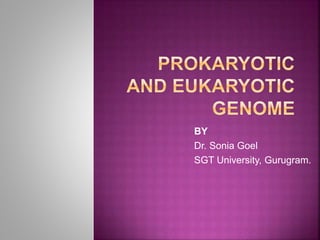
Prokaryotic and eukaryotic genome
- 1. BY Dr. Sonia Goel SGT University, Gurugram.
- 2. 1. Prokaryotic genome Bacterial nuclear body(E.coli) Bacterial chromosome: circular and supercoiled 2. Eukaryotic genome Eukaryotic chromosome
- 3. Bacteria are very small unicellular organisms that do not contain nuclear envelope, mitochondria, endoplasmic reticulum, mitotic apparatus and nucleolus etc., and divide by fission. Bacteria have a rigid cell wall which surrounds their cytoplasmic membrane. Their cytoplasm contains ribosomes. mesosomes and several granular inclusions. About 1/5 of the cell volume is occupied by DNA, the genetic material.
- 4. Bacterial cells do not contain a typical nucleus. But Feulgen reaction shows one, two or more discrete nuclear bodies per cell; these are called nucleoids. The bacterial genome is confined to this nucleoid, which is more or less compact structure without any membrane. When bacterial cells are lysed in the presence of high salt concentration, nucleoids can be recovered intact. The isolated nucleoid may be membrane free or it may be associated with membrane (mesosome). The constituents of the membrane-free nucleoid are DNA (~ 60%) RNA (-30%) and protein (- 10%) DNA forms 2-3% of the dry weight of a bacterial cell).
- 5. Bacterial chromosome is a double-stranded circular DNA. In general, bacterial DNA ranges from 1100 pm to 1400 µm in length. An E. coli cell contains 4. 2 x 106kbp DNA which is about 1.3 mm (1300 µm) in length. Such a long DNA molecule must be greatly folded to be packaged in a small space of 1.7 x 0.65 µm. The bacterial chromosome is folded into loops or domains which are about 100 in number.
- 7. DNA domain: A chromosomal domain may be defined as a discrete structural entity within which supercoiling is independent of the other domains. Thus different domains can maintain different degrees of supercoiling. The DNA chain is coiled on itself to produce supercoiling . The ends of the loops or domains are bound in some way which does not allow rotational events to propagate from one domain to another. If an endonuclease puts a nick in DNA strand of one domain, this loop becomes larger due to the uncoiling, but the other domains are not affected. Each domain contains about 40 kbp (13 µm) of DNA. The loops are bound by some mechanism that may involve proteins and/or RNA but the mechanism is not clearly understood.
- 8. DNA binding proteins: In E. coli, a number of proteins have been isolated which have some similarities with the eukaryotic chromosomal proteins. These proteins are HU, IHF (integration host factor). HI (H-NS) and R It is suspected that HU is involved in the nucleoid condensation. The protein HI probably has effects on gene expression. IHF, RNA polymerases and mRNA may help to organise the nucleoid.
- 9. In eukaryotic cells, the chromosomes are present in a distinct, double-membrane bound structure, the nucleus which occupies on the average about 10% of the cell volume. The membrane is continuous with the endoplasmic reticulum and is provided with pores. The number of chromosome is variable, but fixed for a biological species. Chromosomes change in their physical characteristics during cell division. All these features are absent in the prokaryotic cells. An individual eukaryotic chromosome contains a single enormously large linear ds- DNA molecule.
- 10. The DNA-binding proteins are distinguished into two main types — the histones and non-histone proteins. The histones are basic proteins, rich in basic amino acids, like lysine and arginine. Histones have large amount of positive charges and can bind tightly the negatively charged DNA molecules. These binding results in the formation of the characteristic structural units called the nucleosomes. The long ds-DNA molecule of each chromosome is folded in a very orderly way around the histones to form the nucleosomes.
- 11. All the eukaryotic cells have 5 types of histones : 1. H1 histone: associated with linker DNA 2. H2 histone 3. H2B histone 4. H3 histone 5. H4 histone The nucleosomes are basic structures from which chromatin is made. They are further organized into closely packed 30 nm fibres of chromatin.
- 14. Chromosomes are threadlike deeply stained compact DNA protein complex that carry genetic information in a linear sequence of genes. They are the physical basis of heredity or hereditary vehicles as they store, replicate, transcribe and transmit the genetic information. Though the scope of the term include the bacterial nucleoid (prochromosome), organelle genomes, viral genomes and eukaryotic nuclear chromosome, but only the last one considered as typical chromosome.
- 15. Chromosome number: Each species contain a fixed number of chromosomes (Beneden and Boveri, 1087). However, change in chromosome number can be seen in a species and is called as polyploidy (euploidy and aneuploidy). Normally gamete or gametophyte cells contain one set of chromosomes called genome and the cells are called naploid. The somatic cells of animals and sporophytes have two haploid sets or genomes and are said to be diploid cells.
- 16. A typical chromosome has following parts: (a) Centromere (Primary constriction): A metaphase chromosome has two identical sister chromatids, which are attached to each other at a point called centromere. Based on the position of centromere, chromosomes are called: (i) Telocentric (centromere terminal), (ii) Acrocentric (centromere subterminal and capped by telomere), (iii) Sub-metacentric (centromere is submedian), (iv) Metacentric (centromere median).
- 18. Telomeres: The terminal ends of chromosomes are called telomeres. A telomere is a short repeated DNA sequence (GC rich) complexed with proteins. They are synthesized separately and later add to the chromosomal tips. Ultra-structure of Chromosome: A metaphase chromosome has two sister chromatids, each about 700 nm in diameter. The electron microscopic studies have revealed that, each chromatid consists of a central non histone core called scaffold or nuclear matrix, from which loop of 30 nm chromatin fiber out radially. Each lateral loop is about 300nm long and has up to 100 Kb of DNA.